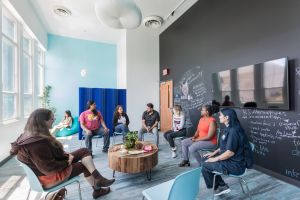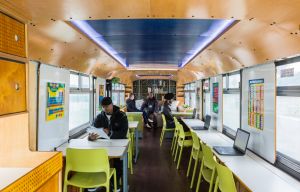Activist Deanna Van Buren Uses Architecture As A Means For Justice
Oakland Activist Uses Architecture For Restorative Justice
Between the United States having one of the highest recidivism rates globally and the school-to-prison pipeline continuing to have a destructive disproportionate impact on youths of color, there is a myriad of societal issues that are indicative of the nation’s historically flawed justice system. What happens when we build physical spaces centered on peace rather than punitive measures? How can we envision justice beyond confinement? Architect and activist Deanna Van Buren—co-founder of the Oakland-based nonprofit Designing Justice + Designing Spaces—is using her passion for design as a means for social change.
According to the Prison Policy Initiative, the incarcerated population in the U.S. has increased by 500 percent within the past four decades; with 2 million people behind bars throughout the country. The criminalization of Black and Brown youth often starts within the classroom as suspensions and expulsions funnel the school-to-prison pipeline; pushing students out of the education system and into the throes of an inequitable criminal justice system. Cognizant of the disparities, Van Buren has dedicated her career to developing architectural projects that counteract mass incarceration and centers healing, reconciliation and peacemaking.
Cultivating safe spaces for refuge has been a common thread throughout Van Buren’s journey. While growing up in a predominately white neighborhood in Stafford County, Virginia during the 70s, she and her family had to navigate a community entrenched with ubiquitous racism and discrimination. For Van Buren, building structures—that she called Healing Huts—made out of household items and toys served as an escape from the sense of tension and isolation that permeated her surrounding environment.
“I think we all have natural ways of coping with stress,” she told NewsOne. “Building spaces for myself and using the environment to calm my nervous system and find nourishment was something I naturally gravitated towards.” Early on, she began to see glimpses of how architecture can be a profound conduit for transformative healing.
Staying true to her childhood vision of becoming an architect, Van Buren charted a path in the design industry. During her graduate studies at Columbia University, the critical need for spaces that promoted restorative justice became even more evident. Just steps away from campus, she bared witness to the inequities faced by the greater Harlem community and pondered how architectural projects could be used to meet the needs of its marginalized residents. Merging activism and architecture was a gradual process for Van Buren. She began her journey by leveraging her design skills to support and elevate an array of grassroots initiatives.
In 2011—after over a decade in the corporate architecture space—she decided to launch her own firm dubbed Designing Justice + Designing Spaces. Founded on the pillars of justice, equity and community, the nonprofit leads design projects that honor the humanity of individuals who have been significantly impacted by unjust systems. “We know the way spaces and environments are designed and thought through can support emotional health and well-being and that has not been integrated into any of our justice infrastructure or reentry infrastructure for that matter,” said Van Buren. Challenging the existence of traditional punitive facilities like prisons, jails and courthouses, she and her team works to develop spaces that address the root causes of mass incarceration including poverty, racism and the lack of accessibility to mental health programs and other resources needed to improve an individual’s quality of life.

Source: Designing Justice + Designing Spaces / Provided
Amongst some of the impactful projects within the organization’s portfolio is Restore Oakland; the country’s first center created to intertwine restorative justice and restorative economics. The space harbors vibrant rooms purposefully designed to foster community, provide support for crime victims, and economically empower low-income families through workforce development programs and entrepreneurship incubators. “When we create places for communities that have been impacted, it’s critical that we’re addressing the multi-faceted nature of justice,” Van Buren shared. “The restorative economic piece is about helping people buy infrastructure so they can stay in place. If you have to deal with displacement due to gentrification, how are you going to anchor a new practice like restorative justice? It’s about the ecosystem, all things are interconnected.”

Source: Designing Justice + Designing Spaces / Provided
Other initiatives include the Five Keys Mobile Classroom which is a refurbished and reimagined MUNI bus repurposed as a traveling schoolhouse. The vehicle—which is equipped with digital learning tools, a classroom space and library—was created to make educational resources accessible in impoverished communities and offer social services to eradicate substance abuse, crime and violence.
Van Buren says a critical element interwoven into the design process is ensuring these projects are truly reflective of the needs of the communities they serve. She believes it’s imperative to center the voices of “systems-impacted” individuals. “We believe in bringing the tools of architecture into the community, teaching those tools and helping folks truly understand what it means to develop these spaces,” she shared. “We have creative ways to engage the community so they can provide meaningful input on what their needs are, both aesthetically and programmatically. We take that data, code it, analyze it and create themes and concepts that get spatialized. If you don’t engage the people who the space is for very deeply, you’re not going to get the right solution.”

Source: Designing Justice + Designing Spaces / Provided
DJDS has worked in concert with a collective of nonprofits to advance their efforts including Restorative Justice for Oakland Youth, the Global Lives Project and WritersCorps. The organization is focused on leading work around designing outlets for trauma survivors as there’s a massive void when it comes to spaces for them to embark on their journeys towards healing.
Van Buren says lasting change starts with deconstructing and dismantling harmful systems that perpetuate cycles of injustice. She believes we can all tap into the power of our distinctive gifts to take a holistic approach toward serving oppressed communities. “We have a lot to unbuild, but then we’ve got a lot to build. We’re in a place where both have to happen at the same time,” she said. “There are a lot of things that we can do with our unique gifts to bring resources to the communities that need them and address the root causes of this problem.”
She hopes her efforts and those of DJDS will serve as blueprints for individuals to create spaces that empower their communities.
SEE ALSO:
Violinist Ezinma Launches Nonprofit To Make Music Education Accessible At Underserved Schools
Oakland Activist Uses Architecture For Restorative Justice was originally published on newsone.com
















